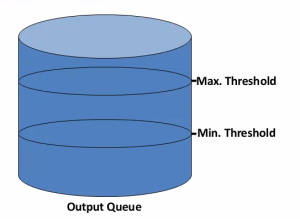RED belongs to congestion avoidance concepts as we spoke already. RED is an industry standard. Check the picture below. We got there output queue with minimum, maximum threshold and its whole capacity. If your queue is full you start dropping packets. We dont want that. Thats why we got minimum threshold. From that point we start droping packets based on our probability. The probability increase while we are closer to maximum threshold. If we reach maximum threshold we drop everything.
Lets check another picture. 25 is our minimum threshold and 45 is maximum. Till we reach 25 we wont drop anything, however being closer to maximum threshold our probability increases. At maximum threshold we have 20% probability and from that if we exceed it its just 1000% because we drop everything.
In Cisco IOS you dont specify exact % value. You type down MPD (mark probability denominator). And the pattern is 1/MDP. So if you want 20 % you must set MDP to 5 cause 1/5 = 0.2 = 20 %.
How do we get different drop probability to different packet flows? With Cisco IOS we can do something called WRED. With WRED we can specify for different flows different thresholds. See the picture.
From the graph you can see that AF13, AF12, AF11 have same likelihood of droping it doesnt matter in what AF group they are, because they are in same WRED profile. What we are influencing in this profile is just minimum threshold.


